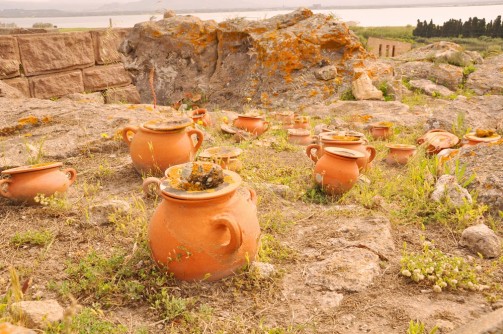The word TOFET is a term of biblical origin for a location near Jerusalem in which special infant-related rituals were practiced; today it is conventionally used to refer to sacred areas of Phoenician and Punic age found in Sardinia, Sicily and Tunisia. The TOFET of Sant’Antioco, used from the 8th cent. B.C. until the 1st cent. B.C., appears as an open-air sacred area, located on the extreme northern outskirts of the town, which leans against a trachytic rock called “Sa Guardia de is Pingiadas” (the guard of the pots) because of the large quantity of cinerary urns, more than 3,000, found over the centuries of the locality. At the foot of that rock, to the south, a quadrangular enclosure of Punic age includes a smaller one of Phoenician age, indicating the spot where the most archaic urns were found. A much larger, rectangular enclosure made of ashlar trachyte blocks and most likely pertaining to a Punic or Roman fort built to defend the area. The urns hold burned bones of children, sometimes of small animals, and a few votive objects. The bone remains for a long time were attributed to a bloody sacrificial rite involving the ritual killing of the first born, while today osteological investigation testifies that most of the babies cremated in the TOFET were stillborn or died of natural causes at an early age, the animal remains, on the other hand, were a component of the rite itself. The urns, usually placed among the natural cavities of the rock, are often accompanied by stone stelae (to date there are about 1,700, preserved in the museums of Cagliari and Sant’Antioco) bearing human, symbolic and, more rarely, animal images related to the ritual that took place in the sacred area.









